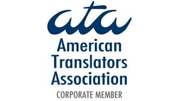What is the International day of Sign Languages?
The International Day of Sign Languages is one of the most recent arrivals in the annual procession of official days, having been introduced by the United Nations as recently as 2017. It is now celebrated annually on 23 September, and aims to recognise and promote the importance of sign languages as essential to ensuring the human rights of deaf people.

The reason the day is on 23 September is that this was the day that the World Federation of the Deaf was founded in 1951.
For individuals and companies working in language, translation or accessibility, International Sign Language Day is a reminder of the importance of embracing all forms of communication and ensuring that language services are inclusive of people of all abilities.
The global importance of sign languages
There are over 300 different sign languages in use today, spoken by approximately 72 million deaf people worldwide. The total number of seriously hearing-impaired people is estimated by the WHO as being about 430 million, or over 5% of the world population. This number includes a large proportion of elderly people of course, whose hearing deficit may be better and more simply supported with hearing aids.

Sign languages are full, natural languages with their own syntax, grammar and lexicon, and like spoken languages, they vary from region to region, and country to country. American Sign Language (ASL), British Sign Language (BSL), French Sign Language (LSF) and Chinese Sign Language (“中國手語”, or ZGS) are among the more widely used sign languages, but most countries have their own unique form of sign communication.
Is there a Universal Sign Language?
This is probably the most commonly asked question about sign language. The answer is a resounding NO. There are at least 300 different sign languages in the world, with most countries having their own language or even languages. Even countries where the same language is spoken, such as English, different sign languages have developed.
This has sometimes been lamented as a great missed opportunity, an area where deaf people could have gotten ahead, but that was always an unreasonable wish, akin to, say, imagining that everybody on Earth should “simply” learn Esperanto, and we can all communicate with one another.
Why are ASL (American Sign Language) and BSL (British Sign Language) so different?
Sign languages have developed from conversations between people in, not based on the spoken language of a country. ASL and BSL have actually developed from different sources, and are therefore part of different sign language trees.
BSL developed from existing British sign languages, and as such was a creation of the British deaf community. Written records of the use of signing as a means of communication go back to the 15th century in the UK.
ASL, by contrast, is most closely related to French Sign Language (LSF). In fact, researchers have traced the development of ASL back to the American School for the Deaf (ASD), founded in 1817 by Thomas Gallaudet, who had previously studied French Sign Language in Paris at the Institution Nationale des Sourds-Muets (National Institution of the Deaf-Mute). Back in the US, at the school that Gallaudet founded, he introduced that methodology, and ASL gradually developed, through language contact with local village sign languages and home sign languages.
For those interested in how sign languages develop in relation to surrounding oral languages, an earlier blog post introduced the important work by Annelies Kusters, and in particular the concept of translanguaging that she applied to sign language users.
The Role of Sign Language in Cultural Identity
Sign languages are so much more than just modes of communication! They are absolutely central to the cultural identities of deaf communities around the world. For many deaf individuals, sign language is the primary means through which they express themselves, form social bonds, and pass down traditions – and it’s a truly wonderful thing to behold!
Deaf communities have rich, vibrant cultures that are expressed through unique forms of storytelling, art, and performance. By recognising and promoting sign languages, we can help to preserve these cultural practices and ensure that they continue to thrive across generations. Furthermore, promoting sign languages fosters greater inclusivity in the global community. By embracing the linguistic and cultural contributions of deaf people, we can work together to break down barriers and create environments where everyone can fully participate.
How can Sign Languages be supported by modern Technology?
In today’s digital age, technology is playing an increasingly important role in supporting communication through sign languages – and it’s an exciting time! It’s amazing to see how innovations like video relay services (VRS), speech-to-text applications, and AI-powered sign language translation tools are making it easier for deaf individuals to communicate with hearing people, both in personal and professional settings!
Video platforms have been a game-changer, opening the door to greater access to sign language interpretation during important events like political speeches, public health updates and educational webinars. It’s a revolution in accessibility!
There’s no doubt about it: businesses that leverage technology to incorporate sign language into their services are not only ensuring compliance with accessibility laws, they’re also demonstrating a commitment to inclusivity and customer satisfaction.
Language service providers have an incredible opportunity to expand their offerings by integrating sign language interpretation into their translation and localisation services. This can enhance their marketability to organisations that require accessible content, such as government agencies, educational institutions, and healthcare providers.
How Individuals and Businesses Can Support Sign Language on the International Day of Sign Languages and beyond
- Learn Basic Signs: Take the opportunity to learn some basic signs in your local sign language. Apps, online tutorials and local classes can help you get started. Understanding even just a few common phrases like “thank you” or “hello” shows respect for the deaf community and can break down communication barriers.
- Engage with Deaf Culture: Attend performances, art exhibitions or film screenings created by deaf artists and filmmakers. Many events take place online or in major cities around the world. These cultural experiences provide insight into the role of sign language in shaping cultural identity, and highlight the creativity and expression of the deaf community.
- Support Deaf Creators: Check out content creators, educators and influencers who use sign language on their platforms. By following and supporting Deaf creators on social media, you’ll not only learn more about their experiences, but also amplify their voices and reach.
- Become an Advocate: We can all make a difference! We can spread the word about the importance of sign language interpreters in our workplaces, schools and social circles. Together, we can make communication accessible for all!
- Offer Sign Language Training: Provide sign language training to employees, especially those in customer-facing roles. Give your staff the tools they need to communicate effectively with deaf customers and show your commitment to accessibility.
- Ensure Website Accessibility: Businesses can audit their digital platforms and ensure they are accessible to the deaf community. This could include adding subtitles and sign language interpretation to video content, as well as ensuring that navigation and service options are easy to use for all customers.
- Hire Deaf Talent: Companies should explore opportunities to hire deaf people in a variety of roles, not just in accessibility or sign language services, but across all departments. Providing a supportive work environment for deaf employees – including access to sign language interpreters and assistive technology – promotes an inclusive workplace culture.
- Partner with Accessibility Providers: Partnering with companies that specialise in sign language interpreting or captioning services (such as Rosetta Translation) can enhance a company’s ability to provide fully inclusive services. This is particularly important for events, conferences and webinars where companies want to reach a diverse and inclusive audience..
The Future of Sign Language and Accessibility
Looking ahead, the use of sign language is expected to grow as more people and businesses recognise its value in fostering inclusivity. The integration of AI and digital tools into sign language interpretation will likely make communication even more seamless, but it’s important to remember that these technologies must complement human interactions, not replace them.
For the deaf community, continued advocacy and awareness-raising efforts are essential for ensuring that sign language is respected and integrated into all areas of public life. Businesses, organizations, and individuals must continue to support these efforts, not just on International Day of Sign Languages, but throughout the year.
The International Day of Sign Languages is a powerful reminder that communication is a fundamental human right. Whether you are an individual learning a few signs or a business offering fully accessible services, embracing sign language is a meaningful way to promote inclusivity and equal access for all. By celebrating and supporting sign languages, we contribute to a world where everyone can communicate, connect, and thrive, regardless of their abilities.
About the Author
Eric Fixmer
Eric is the Managing Director and founder of Rosetta Translation. Originally from Luxembourg, he holds a PhD in phonetics from Cambridge University and he started Rosetta in 2004, leading the company from his living room to being a leading international provider of language services with offices in Europe, Asia and America… Read Full Bio









